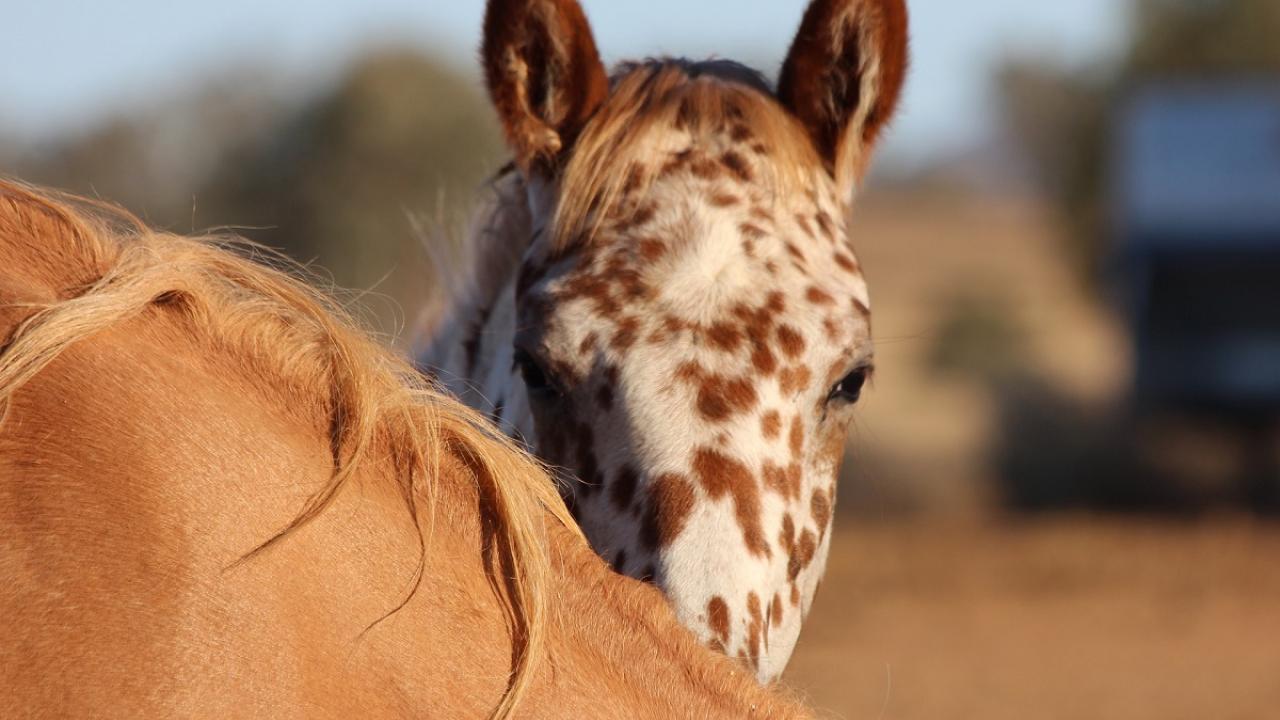
Congenital Stationary Night Blindness (CSNB)
Takeaways
- Congenital stationary night blindness (CSNB) is the inability to see in low to no-light conditions.
- Horses with two copies of the leopard complex white spotting pattern allele (LP) have CSNB. This includes horses from the Appaloosa, Miniature Horse, and Knabstrupper breeds, among others.
- Other breeds without leopard complex spotting have also been reported to have this condition and further research will likely identify other mutations.
- The genetic cause for CSNB in an affected Tennessee Walking Horse (CSNB2) has recently been identified.
- There is no cure for CSNB, but affected horses can be managed successfully under low light conditions.
- Two genetic mutations (LP and CSNB2) have been identified that cause CSNB, and DNA tests are available.
What is congenital stationary night blindness?
Congenital stationary night blindness (CSNB) is the inability to see in low to no-light conditions (essentially dusk to dawn). It is found in horses with two copies of a specific white spotting pattern mutation known as leopard complex spotting (LP), which is characterized by a symmetrical white pattern centered over the rump with few or no spots of pigment in this white patterned area. This coat pattern is common in Appaloosas, Miniature Horses, Knabstruppers, Norikers, and some other breeds.
The disease is the result of abnormal cell signaling from the rods, or low light detecting cells of the retina, to the next cell in the visual pathway, known as the ON bipolar cells. In affected horses, the rods do not properly transmit their signal to the ON bipolar cell, resulting in blindness at night.
A genetic mutation has been identified that causes this condition in the Appaloosa and related breeds. The mutation is in a calcium ion channel gene known as transient receptor potential cation channel subfamily M member 1 (TRPM1) gene and a DNA test is available.
Additionally, a different genetic variant in the metabotropic glutamate receptor 6 (GRM6) gene was recently identified in a CSNB affected Tennessee Walking Horse. Although this was a single case, the frequency of the causative allele was determined to be 10% in this breed, suggesting that genetic testing, followed by clinical examination, is warranted. This has been termed CSNB2 as it is the second variant thought to cause CSNB in horses (LP is the first).
There are other breeds affected by this condition and research is ongoing to identify the genetic mechanism in breeds such as the Paso Fino and Thoroughbred.
What are the clinical signs of congenital stationary night blindness?
Congenital stationary night blindness is present at birth and is nonprogressive, meaning that it does not worsen with age. Affected horses likely have normal vision during daylight, unless also affected with other eye problems, such as cataracts or equine recurrent uveitis.
Horses with CSNB may exhibit anxiety, apprehension, and confusion in low light conditions. They may be reluctant to move, bump into things, or be prone to injury at night. They may also exhibit resistance to entering dark stalls, trailers, barns, and other dimly lit spaces.
How is congenital stationary night blindness diagnosed?
Electroretinography (ERG), which measures the electrical activity of retinal cells in response to light, can be used to diagnose CSNB. A veterinary ophthalmologist must perform this specialized procedure. The available DNA test for LP can be utilized for a definitive diagnosis at any age.
How is congenital stationary night blindness treated?
There is no cure for CSNB. However, many affected horses can be successfully managed. Horses with CSNB should be provided with a safe, comfortable, familiar location during the night. Stall lights should be kept on at night. For horses that live in pastures full time, electric fencing that produces a clicking sound can be used to help them navigate and it also recommended to place them with a seeing pasture mate at night. Be sure to give affected horses sufficient time to adjust to new surroundings during daylight hours.
What is the prognosis for congenital stationary night blindness?
Horses with CSNB have reduced to no vision at night. It is not possible to tell by behavior if they are night blind as horses respond differently to this condition. In some situations, these horses may be difficult to train. However, since affected horses generally see no differently than other horses during daylight hours, many can be used for riding or performance. Proper management under low light conditions is essential to ensure the safety of the horse and its handlers.
How can congenital stationary night blindness be prevented?
Breeders and owners can utilize the DNA test for LP to make informed mating decisions and to manage those horses with two copies of LP that will be affected with CSNB. The CSNB2 genetic test is appropriate for Tennessee Walking Horses. At this time, it is recommended that horses testing CSNB2/CSNB2 also be evaluated by a veterinary ophthalmologist. Hair samples may be submitted for testing to the UC Davis Veterinary Genetics Laboratory.
For more information:
UC Davis Veterinary Genetics Laboratory Leopard Complex (Appaloosa spotting) genetic testing
Bellone, R.R., Holl, H., Setaluri, V., Devi, S., Maddodi, N., Archer, S., Sandmeyer, L., Ludwig, A., Foerster, D., Pruvost, M., Reissmann, M., Bortfeldt, R., Adelson, D.L., Lim, S.L., Nelson, J., Haase, B., Engensteiner, M., Leeb, T., Forsyth, G., Mienaltowski, M.J., Mahadevan, P., Hofreiter, M., Paijmans, J. L.A., Gonzalez-Fortes, G., Grahn, B., & Brooks, S.A. (2013). Evidence for a Retroviral Insertion in TRPM1 as the Cause of Congenital Stationary Night Blindness and Leopard Complex Spotting in the Horse. PLoS ONE, 8(10):e78280. doi: 10.1371/journal.pone.0078280
Hack, YL, Crabtree, EE, Avila, F, et al. 2021. Whole-genome sequencing identifies missense mutation in GRM6 as the likely cause of congenital stationary night blindness in a Tennessee Walking Horse. Equine Vet J. 53(2):316-323.
*This article may not be reproduced without the written consent of the UC Davis Center for Equine Health. Please email requests to cehadmin@ucdavis.edu.
